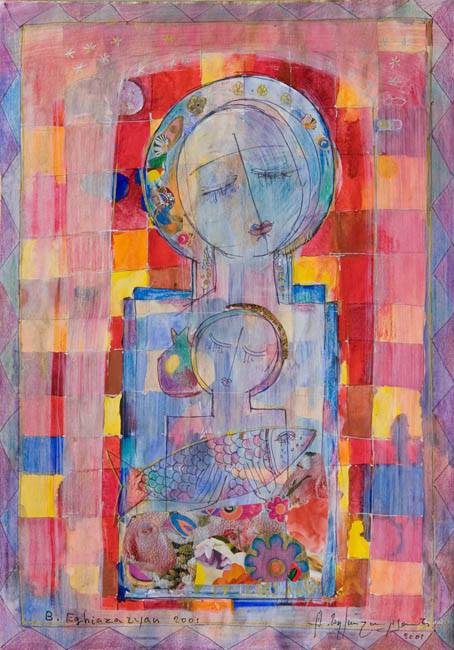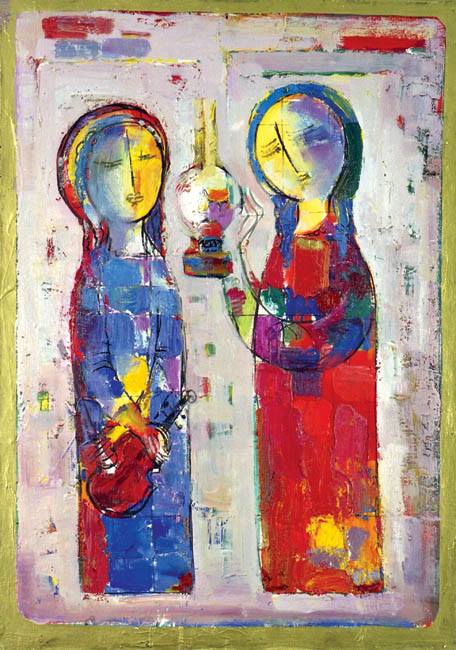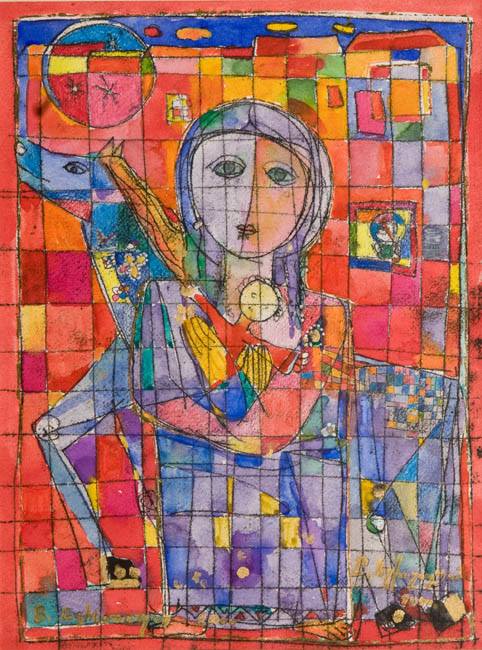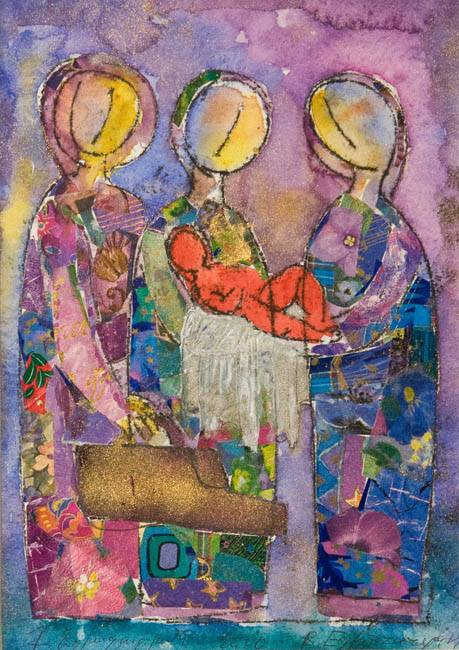
Thanks be!
Lusine Yeghiazaryan
How should I begin an article about Boris Yeghiazaryan? Kiyvite… Armenian… contemporary… timeless… avant-garde… simple-traditional artist. Any of these words would serve as a good starting point to consider his work. However, it seems much more interesting to combine all these factures to form a picture of one man and his creativity.
In fact, when you know about the path that Boris’ education and creativity have taken him along, this fantastic mélange does not seem so surprising at all. It begins in Yerevan, at the Terlemezyan College of Creative Art. Then comes The “Muhinka” in St. Petersburg, followed by a period back in Yerevan at the Institute of Theatre Art and, finally, at the Academy of Art in Kyiv, from which he graduated in 1986. It was a terribly long odyssey which eventually took Boris to his Ithaca: a borderless land of fine art.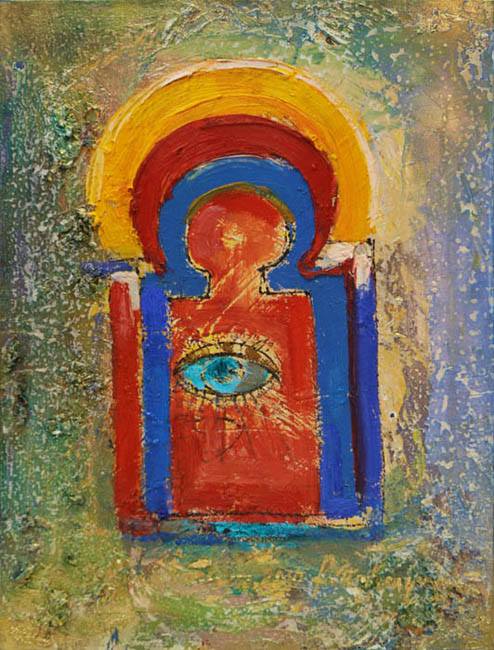
25 years ago, nobody, not even his closest relatives, could say what made the boy from the Mountain village of Aparan, want to study such odd subjects as drawing and painting. And yet everything around him in his childhood: the nature of the mountains, Aragatz – the most wonderful mountain of all, with its cold springs, peacefulness and thrilling expanses – everything cried out “Paint! Paint!” And he obeyed.
Most certainly the artist in Boris Yeghiazaryan appeared during his childhood, in his little homeland. There is no doubt about it, he is an Armenian. As I see it, his works contain everything that is quintessentially Armenian, especially the colour. Just look at the paintings of Saryan, Aveticyan.
Oh that Armenian colour – the expression, the wonder, the brightness of life. The piercing, sunshine colour of the canvas where even deep blue in thick green bursts inti flames! And there, amid the flames, the calm of the ancient miniatures or frescos which Boris so loves gaze upon himself. Here, even the molten yellow and the war- like red become peacekeepers.
Or most simply – white canvas with white paint, the gold contours of a figure. White is the colour of cleanliness and the figure is an ancient Christian drawing on stone which the artist once saw. The viewer cannot help but be surprised.
But Boris Yeghiazaryan is not an Armenian artist. He is Ukrainian-Armenian; a Kiyvite from Yerevan, and there is no getting away from it. Kyiv has become his second creative home. In his bright, stormy works, the velvet tones, the soft shadows and the fine, transparent layering are Ukraine.
And then any artist belongs to his public, and Boris has as many fine admirers and friends in Kyiv as he has in Yerevan. They live in his Armenian head and his portraits; all extremely beautiful: “Woman with the Crocuses”, “Young Girl with the Long Neck” and “Scottish Girl with a Violin”. There are probably hundreds of others hanging on walls all over the world… The fact is that friends appear wherever he goes with his festive paintings and exhibitions: in Greece, Switzerland, France, America…
An art critic once said that Boris was a teller of fairy tales and that his works are joyful fairy stories. I do not agree. After all, he has not spent all his life in a studio staring at canvases. There have been many difficult and painful times. There was the Karabakh Campaign, in which Boris took an active part, and even war! Once, the KGB came to his home where his wife was nursing their baby daughter. There was the worst nightmare of all artists: a fire in his studio, where he lost 10 years of work. Through all these experiences, he found his way to God. Boris does not paint fairy tales. He paints life! “Love”, “Birth”, “A Wonderful Journey”, “Ponderings”, “Man”: this is not the stuff of fairy tales.
The openness, joy and peace of his works reflect life as it should be, the life for which people were created. Yeghiazaryan tries to show God’s love; God’s love towards the people which Yeghiazaryan makes a daily attempt to understand by reading the Bible. That must be why it is so pleasant to see his works on walls, because where his works are, there is the Lord’s love: its purity, joyfulness and peace.
As Boris likes to say about his own work: “Thanks be to God”, and that’s just it: thanks be!
Aleksei Titarenko
Boris Yeghiazaryan is a teller of fairy tales. Like all such folk, his life has not been easy. He has come from isolation in a KGB cell, where he drew on the walls to keep from going mad; from commanding a regiment in the Armenianmountains during the struggle for independence. He has come from that to the creation of pure and bright images. And I stress the word “images”. For me, his works are icons, not in the sense in any canon, the canon is not important here. The important thing is the spirit. It is the way you put his canvas on the easel and the studio is flooded with light. According to orthodox tradition, light is the emanation, the outpouring of light-goodness-love. Borya’s love smooths my doubt and, I suspect, not only mine, but all the creases in this crumpled world.
For the post-modern mind, brought up on Derrida and Co, the fin de siècle charm has been lost in creases of life. We are carried into a new time where, once more we want to speak about love and harmony, a time of clear and pure accords from which we want to make a new start. The time has come to build. We have destroyed things long enough. Borya criss-crosses his canvases with lines more strongly than Tintoretto. Is this a subconscious desire for walls? Give Borya walls and he will build “the city of happiness” about which Korbousier dreamed: a city with a smooth unity of architecture.
Yeghiazaryan’s architecture is joyful. Where north is, where south is, the time of day; none of that matters. Is it a river or is it a sky through which the little boat is sailing? On board there is a couple in love; young girls are holding up wonderful fish; we can hear music.
At thr 50thVenice Biennale, the prize winner of the “Golden Lion” award was the young Chinese girl from Luxemburg, Su Mai Zi. She played the cello with Alpine swings. Something very good had happened in the world; a ray of sunshine, the ice melted and a rainbow appeared. We no longer see the world in shades of grey and here Yeghiazaryan is a lighthouse. We can place his work in the long, long halls of imaginary “great museum of art” of Malerot. The endless Armenian light will glisten like precious stones. We read how the Armenians carried their Bibles clutched to their breasts during the many times of disaster and wanderings. We are lucky enough to see them, not faded, but in all their ancient glory.
A clean, strong prayer will always drive out darkness. But can any ordinary, contemporary artist paint like that? I doubt it. Yeghiazaryan is from another world – a teller of fairy stories, as I said. I cannot help thinking that if you could get all of us – the worn down, reactionary doubters – if you could get us all together on a hill, and have Borya in front of us, with a huge canvas, painting all his “concerts”, his “walks”, his “childhood home”, then something would change, both in us and in our world. Why? Because he is not painting some accidental flow of life, some subjective fantasy. He is painting goodness and love from which emerges the warm and humane attitude to the world which is so lacking in our lives today.
Borya’s lines are “Matisse light” and inspiring. It is as if he is feeling around in the chaos of our crumpled world and, finding the right thread, he leads us out to the light – Fellini’s Orchestra after a rehearsal – the rehearsal is left behind the mountains of warring Armenia.
Just listen. It is a rare artist who can achieve such purity and wise simplicity of harmony: Whitman, Matisse, Hunderswasser, Yeghiazaryan. Are these the artist Nitzsche dreamed of – the profits? And aren’t they what we worn down, doubting folk need most of all?
Andrey Kurkov
Art can either liberate the artist from reality or, vice versa, it can free reality from the artist. In the first case, the artist works in a world of abstractionism; a world of lines and colour and codes. In the second, the colours are condensed so that life is forced to see its own unflattering reflection. But there is a third way: to attempt what Boris Yeghiazaryan manages to achieve – to respond to life’s cruelest blows with the utmost kindness and love. Life contains little of the calmness and happiness that we sense in Boris’ works. However, with each new work that appears, our world imbibes a little more of the goodness it so lacks. Even the casual viewer is bound to absorb some of the affection for life that Boris has poured into his works.
Kindness, is not, of course, a criteria by which art can be judged, but it is banal to talk about Boris’ mastery and his talent. He wrought his creative world while living in Armenia. And, when life led him to Kyiv, Boris brought that world with him, enriching our city no end. “The Woman with Pomegranate”, “Noah’s Arch”, “The Birth of Musician” and many other canvases create a bright and unified ABC of imagery of a better world.
I have the feeling that his paintings have the power to prolong the lives of those who look on them. I do not mean this is any mystical sense. It is simply that a happy person should live longer than a sad one and Boris Yeghiazaryan’s works exude happiness and vitality.
Hanni Malcotsis-Ursprung
Galerie “Anixis”, Baden, Switzerland
In his paintings Boris Yeghiazaryan interlaces different kinds of creatures. Human, birds and trees interact in a unique and lively composition. These motifs are woven together like a basket of all fine gifts of life. Flying angels and floating fishes impart an incredible ease to the images, conveying a feeling of freedom and peace.
Through expert painting and collage techniques Boris Yeghiazaryan achieves a rich narrative quality in his works. The colours are luminescent, the figures quite simple. Maybe it is this very simplicity that touches the soul and leads us on a lyrical walk back to childhood, reawakening the familiar sense of harmony and safety.
Galia and Michel Ghienne
At the end of the 1990s, we were in Kyiv and we some Boris Yeghiazaryan’s works on Andriyivskiy Uzviz. Then we found ourselves in his studio. We were enchanted. We saw something new, unimaginable, something that we had not seen before. By and by, we became owners of several of his works. His art is unforgettable. We not only wanted to own some of his paintings, we also wanted our friends and other people in our country to see them. That was how we came up with the idea of our own gallery. And that was how the “Galia” Gallery in Bordeaux was born.
We were able reveal the works of Boris Yeghiazaryan and that of other great Ukrainian artists to France.
The most amazing thing about Boris’s art is that you never get used to it. Every time you look, you discover something you have not seen before, and it gives you more light and warmth.
Gussie Fauntleroy
USA, Santa Fe
Art of Russia Gallery
Gussie Fauntleroy is an award-winning writer and the author of ExtraOrdinary People: Roxanne Swentzell
Boris Yeghiazaryan has been said to approach the canvas as a mature artist with the sweet and innocent perspective of child, or conversely, as an exuberant and playful child with an old man’s wise vision and appreciation of beauty. Either way, Yeghiazaryan’s paintings combine seemingly simple yet sophisticated designs, with vibrant color and life. Employing distinctive personal repertoire of symbols and recurring motifs, his work is utterly contemporary, yet imbued with a sense of timelessness.
Yeghiazaryan was born in the Armenian hill village Aparan, later studied at some most distinguished art schools of former Soviet Union: Yerevan Art College in Armenia, the Mukhina Art Institute in St. Petersburg, and the Kyiv Art Academy. After achieving a high degree of technical mastery in graphic design and realist painting, in the early 1990s he shifted away from strict realism in his art. He began turning instead to the realm of childhood memory and joyful simplicity. Themes of motherhood, family, community, music, security, warmth and love reflect the artist’s deep roots in Armenian Christianity, and his personal standards of kindness and gratitude.
In fact, three cultural traditions find expression in Yeghiazaryan’s work. From Armenia comes the intensity of color associated with a southern climate and tradition of miniaturist painting. From the great heritage of ancient icons come aspects of composition, the use of gold leaf, and a sense of triumph and joy. And a soft tenderness in the figures’ features can be traced to the inspiration of Russia classical art. Uniting these diverse qualities is a distinctly modernist touch, often incorporating geometric elements and a deliberate simplicity of style.
Yeghiazaryan’s creative portfolio includes frescos, mural painting, stained glass, sculpture, collage, and poetry. But it is his passionately spirited and engaging oil and watercolor painting that constitutes the literal and figurative of his career.

